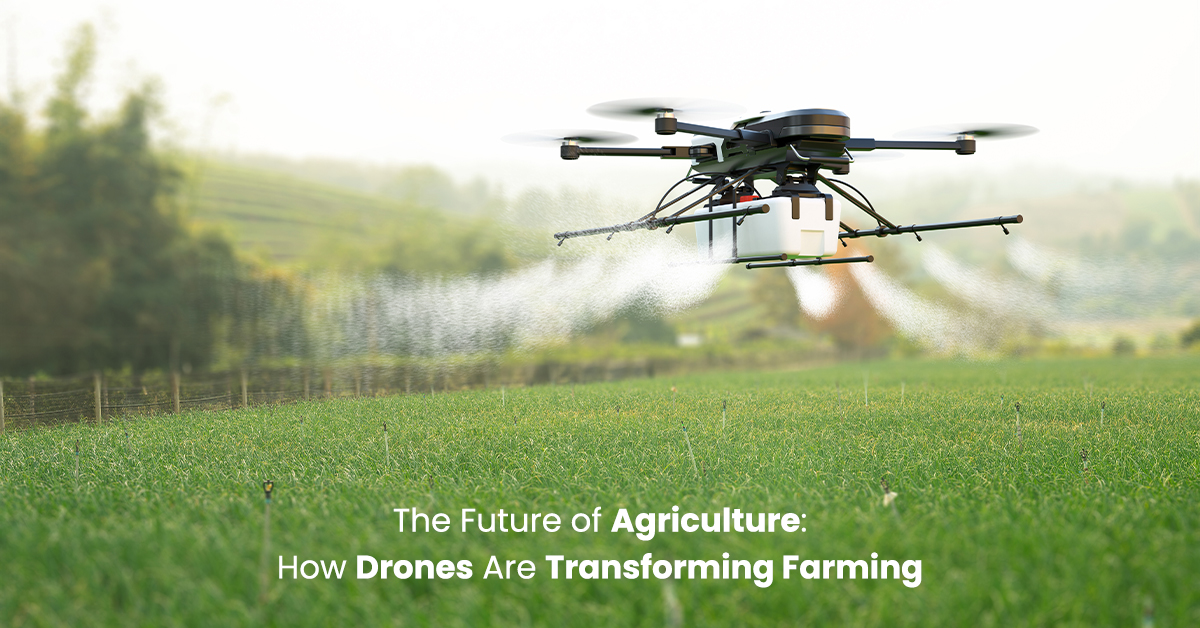The Future of Agriculture: How Drones Are Transforming Farming
With technological advancements at an unprecedented pace, various industries are undergoing transformative changes, and the agriculture sector is no exception. Drone farming is one such innovation with immense potential for revolutionizing farming practices.
With the proven ability to overcome the limitations of age-old agricultural practices, drone technology in agriculture has enabled farmers to embrace smart farming techniques. This article will teach us how leveraging intelligent solutions such as drones can significantly improve productivity, efficiency, and sustainability.
Limitations of Traditional Farming Practices
Farmers have relied on traditional agricultural methods characterized by labour-intensive tasks and limited resources for centuries. The arduousness combined with unpredictable weather patterns has had a significant impact on the farmers themselves. The farmers faced physical strain, long working hours, and uncertain outcomes.
A challenging endeavour and the repercussions extended to the crops and the people dependent on agriculture. However, with threats to food security and economic stability, it became clear that a more advanced and efficient approach is needed.
Pioneering Smart Agriculture for a Sustainable Future
Smart farming, also known as precision agriculture, integrates technology and data-driven methodologies to optimize agricultural processes. Smart farming benefits farmers a lot by leveraging technological advancements like sensors, IoT devices, satellite imagery, and artificial intelligence. From making informed decisions to enhanced resource management, farmers have observed maximized crop yields while minimizing environmental impact.
Among the variety of technologies discovered, drones have emerged as game-changers!
Adoption & Benefits of Drone Farming
The adoption of drone farming is proliferating. In 2019, the global market for agricultural drones was valued at $1.2 billion. Furthermore, the drone farming price is expected to grow to $10.8 billion by 2025. Several factors, including the increasing availability, the development of new drone-based technologies, and the growing demand for sustainable agriculture, have driven the growth of drones in the agriculture sector.
Types of Drones Used in Agriculture
Several types of drones are commonly used in farming. Each type has capabilities and features that make it suitable for different tasks.
- Fixed-Wing Drones: This type of drone resembles a miniature airplane, where the fixed-wing design allows these drones to cover more ground. They are commonly used in agriculture for mapping fields, monitoring crops, and detecting pests. They can gather high-resolution aerial imagery of farmland for crop health analysis.
- Single-Rotor Drones: These drones are also popularly known as helicopter drones, which capture data for crop mapping and analysis. They can hover in place longer than fixed-wing drones and offer more precise data collection. The single-rotor drones are equipped with advanced sensors and cameras to help collect data on crop health, soil conditions, and environmental factors.
- Multi-Rotor Drones: These are highly maneuverable and can fly in any direction, making them ideal for close-range operations such as crop monitoring and analysis. They are often used for mapping and surveying large agricultural areas, providing high-resolution aerial imagery to identify livestock and crop health and monitoring pest or disease outbreaks. Some multi-rotor drones are equipped with thermal cameras to detect temperature variations in crops and help farmers to detect stress.
Key Benefits & Applications of Drone Technology in Agriculture
- Crop Monitoring and Assessment: Drones provide farmers with real-time data on crop health, growth patterns, and areas requiring attention. High-resolution imagery and multispectral sensors allow for the early detection of pests, diseases, nutrient deficiencies, and irrigation issues. This enables timely interventions, resulting in precise treatments, thus minimizing the use of chemicals.
- Precision Spraying and Seeding: Drones equipped with spraying systems can precisely apply fertilizers, pesticides, and herbicides to crops, reducing wastage and minimizing environmental contamination. In addition, drones can accurately distribute seeds and optimize planting procedures.
- Irrigation Management: By capturing thermal and multispectral imagery, drones assess moisture levels and identify areas with insufficient or excessive water. This helps in precise irrigation planning, minimizing water usage, and reducing costs while ensuring optimal crop growth.
- Crop Mapping and Planning: Drones with mapping capabilities create detailed aerial maps of fields, offering farmers valuable insights into soil variability, topography, and drainage patterns. This data assists farmers in creating customized planting and cultivation plans, optimizing resource allocation, and maximizing yields.
- Livestock Monitoring and Management: Drones also play a crucial role in livestock management. From monitoring grazing patterns and herd health to identifying hazards and assisting in search and rescue operations, farmers can leverage drones to improve efficiency.
Despite some challenges to using drones in agriculture, the adoption of drone farming has gained momentum worldwide. It is expected to continue to grow in the coming years. Drones have empowered farmers to embrace smart farming techniques and experience increased efficiency, reduced labour, improved resource utilization, and enhanced sustainability.
Conclusion:
With its ability to make data-driven decisions, optimize operations, and maximize profits, drone technology is revolutionizing agriculture. The agriculture sector is driven towards a prosperous and environmentally friendly future with the help of drone farming. As technology continues to evolve, we can anticipate even more significant advancements and broader adoption of drone farming, further transforming how we cultivate our lands and feed our growing population.

